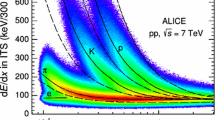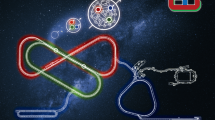Abstract
An Electron-ion collider in China (EicC) has recently been proposed, for imaging the precise and detailed internal structures of hadrons, understanding the emergent properties of nucleon (such as the nucleon mass and spin) and the emergence of nuclear medium effect, and studying the exotic hadronic states. By exploiting the abundant “pion cloud” around the proton, an experiment of measuring the pion structure is suggested, and it is one of the physics highlights at the EicC facility. In this paper, we present a simulation study of the proposed pion structure experiment. At EicC, the pion structure information is accessed via the leading-neutron tagged deep inelastic scattering—the widely acknowledged Sullivan process of pion exchange with small momentum transfer. We briefly discuss the theoretical framework of our event generator and the current design of the experimental setup for the experiment. We then evaluate the statistical errors of the pion structure function that would be extracted from the proposed measurement under the integrated luminosity of 50 fb\(^{-1}\). The sensitivity and precision to pion parton distribution functions are also demonstrated with a global fit. The precise quark distributions of the pion can be achieved at EicC in the range of \(0.05<x_{\pi }<0.95\), and the pion gluon distribution also can be constrained by the global fit of the pseudo-data at various \(Q^{2}\).















Similar content being viewed by others
References
D.P. Anderle et al., Front. Phys. (Beijing) 16(6), 64701 (2021). https://doi.org/10.1007/s11467-021-1062-0
R. Abdul Khalek et al., Nucl. Phys. A 1026, 122477 (2022). https://doi.org/10.1016/j.nuclphysa.2022.122447
A. Accardi et al., Eur. Phys. J. A 52(9), 268 (2016). https://doi.org/10.1140/epja/i2016-16268-9
G. Xie, M. Li, C. Han, R. Wang, X. Chen, Chin. Phys. C 45(5), 053002 (2021). https://doi.org/10.1088/1674-1137/abe8cf
R. Wang, X. Chen, Few Body Syst. 63(2), 48 (2022). https://doi.org/10.1007/s00601-022-01751-3
Y. Nambu, Phys. Rev. 117, 648 (1960). https://doi.org/10.1103/PhysRev.117.648
J. Goldstone, A. Salam, S. Weinberg, Phys. Rev. 127, 965 (1962). https://doi.org/10.1103/PhysRev.127.965
J.M. Cornwall, Phys. Rev. D 26, 1453 (1982). https://doi.org/10.1103/PhysRevD.26.1453
C.D. Roberts, A.G. Williams, Prog. Part. Nucl. Phys. 33, 477 (1994). https://doi.org/10.1016/0146-6410(94)90049-3
P. Maris, C.D. Roberts, Phys. Rev. C 56, 3369 (1997). https://doi.org/10.1103/PhysRevC.56.3369
P. Maris, C.D. Roberts, P.C. Tandy, Phys. Lett. B 420, 267 (1998). https://doi.org/10.1016/S0370-2693(97)01535-9
X. Gao, A.D. Hanlon, S. Mukherjee, P. Petreczky, P. Scior, S. Syritsyn, Y. Zhao, Phys. Rev. Lett. 128(14), 142003 (2022). https://doi.org/10.1103/PhysRevLett.128.142003
H.W. Lin, J.W. Chen, Z. Fan, J.H. Zhang, R. Zhang, Phys. Rev. D 103(1), 014516 (2021). https://doi.org/10.1103/PhysRevD.103.014516
M. Ding, K. Raya, D. Binosi, L. Chang, C.D. Roberts, S.M. Schmidt, Phys. Rev. D 101(5), 054014 (2020). https://doi.org/10.1103/PhysRevD.101.054014
Z.F. Cui, M. Ding, F. Gao, K. Raya, D. Binosi, L. Chang, C.D. Roberts, J. Rodríguez-Quintero, S.M. Schmidt, Eur. Phys. J. C 80(11), 1064 (2020). https://doi.org/10.1140/epjc/s10052-020-08578-4
C. Shi, C. Mezrag, H.S. Zong, Phys. Rev. D 98(5), 054029 (2018). https://doi.org/10.1103/PhysRevD.98.054029
C. Chen, L. Chang, C.D. Roberts, S. Wan, H.S. Zong, Phys. Rev. D 93(7), 074021 (2016). https://doi.org/10.1103/PhysRevD.93.074021
J. Badier et al., Z. Phys. C 18, 281 (1983). https://doi.org/10.1007/BF01573728
B. Betev et al., Z. Phys. C 28, 9 (1985). https://doi.org/10.1007/BF01550243
J.S. Conway et al., Phys. Rev. D 39, 92 (1989). https://doi.org/10.1103/PhysRevD.39.92
S. Chekanov et al., Nucl. Phys. B 637, 3 (2002). https://doi.org/10.1016/S0550-3213(02)00439-X
F.D. Aaron et al., Eur. Phys. J. C 68, 381 (2010). https://doi.org/10.1140/epjc/s10052-010-1369-4
J.D. Sullivan, Phys. Rev. D 5, 1732 (1972). https://doi.org/10.1103/PhysRevD.5.1732
H. Holtmann, G. Levman, N.N. Nikolaev, A. Szczurek, J. Speth, Phys. Lett. B 338, 393 (1995)
S.X. Qin, C. Chen, C. Mezrag, C.D. Roberts, Phys. Rev. C 97(1), 015203 (2018). https://doi.org/10.1103/PhysRevC.97.015203
R. Wang, tagged-neutron-dis (2023). https://github.com/rong-wang-impcas/tagged-neutron-DIS
P.C. Barry, N. Sato, W. Melnitchouk, C.R. Ji, Phys. Rev. Lett. 121(15), 152001 (2018). https://doi.org/10.1103/PhysRevLett.121.152001
G. Xie, C. Han, R. Wang, X. Chen, Chin. Phys. C 46(6), 064107 (2022). https://doi.org/10.1088/1674-1137/ac5b0e
C. Han, G. Xie, R. Wang, X. Chen, Eur. Phys. J. C 81(4), 302 (2021). https://doi.org/10.1140/epjc/s10052-021-09087-8
Y.L. Dokshitzer, Sov. Phys. JETP 46, 641 (1977)
V.N. Gribov, L.N. Lipatov, Sov. J. Nucl. Phys. 15, 438 (1972)
G. Altarelli, G. Parisi, Nucl. Phys. B 126, 298 (1977). https://doi.org/10.1016/0550-3213(77)90384-4
M. Botje, Comput. Phys. Commun. 182, 490 (2011). https://doi.org/10.1016/j.cpc.2010.10.020
J. Pumplin, D. Stump, R. Brock, D. Casey, J. Huston, J. Kalk, H.L. Lai, W.K. Tung, Phys. Rev. D 65, 014013 (2001). https://doi.org/10.1103/PhysRevD.65.014013
A.D. Martin, R.G. Roberts, W.J. Stirling, R.S. Thorne, Eur. Phys. J. C 28, 455 (2003). https://doi.org/10.1140/epjc/s2003-01196-2
A.C. Aguilar et al., Eur. Phys. J. A 55(10), 190 (2019). https://doi.org/10.1140/epja/i2019-12885-0
Acknowledgements
We thank Profs. Craig D. Roberts and Tanja Horn for the fruitful discussions and the constructive questions. We are also very grateful to Dr. Jixie Zhang for his friendly help in the simulation and the cross-checks. This work is partly supported by the Strategic Priority Research Program of Chinese Academy of Sciences under the Grant NO. XDB34030301 and the National Natural Science Foundation of China under the Grant NO. 12005266.
Author information
Authors and Affiliations
Contributions
RW wrote the main manuscript text. RW and GX did the simulation and the data analysis. WX and YL prepared the Figs. 3 and 4. WX, YL and XC gave many valueable suggestions on the physics, the proposal of the experiment, and the analysis of the simulation data. All authors reviewed the manuscript.
Corresponding author
Ethics declarations
Competing interests
The authors declare no competing interests.
Additional information
Publisher's Note
Springer Nature remains neutral with regard to jurisdictional claims in published maps and institutional affiliations.
Rights and permissions
Springer Nature or its licensor (e.g. a society or other partner) holds exclusive rights to this article under a publishing agreement with the author(s) or other rightsholder(s); author self-archiving of the accepted manuscript version of this article is solely governed by the terms of such publishing agreement and applicable law.
About this article
Cite this article
Wang, R., Xie, G., Xiong, W. et al. An Impact Study on the Pion Structure Measurement at EicC. Few-Body Syst 64, 28 (2023). https://doi.org/10.1007/s00601-023-01811-2
Received:
Accepted:
Published:
DOI: https://doi.org/10.1007/s00601-023-01811-2




